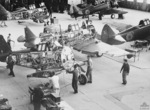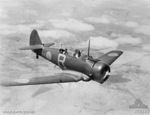Wirraway
| Country | Australia |
| Manufacturer | Commonwealth Aircraft Corporation |
| Primary Role | Other |
| Maiden Flight | 27 March 1939 |
Contributor: Morgan Bell
ww2dbaseImmediately before the Second World War, the Royal Australian Air Force (RAAF) had no fighter aircraft that could be classed as modern. With war on the horizon and the threat of aggression approaching at a frightening pace, Australia's air force's options were almost as limited as its stock of fighter aircraft: it could place orders with other nations for the necessary equipment; or it could construct its own fighter aircraft locally. The first option did not look promising as the drumbeat of war increased in frequency in the closing years of the thirties, Australian orders for aircraft in other countries would struggle to be noticed amongst a high number of orders being attended to for countries mobilizing their armed forces. Local production might have offered a solution, but Australian manufacturing industry was underdeveloped as the dominion had grown comfortable with purchasing British manufactured goods, giving Australian industry little breathing room to compete with the British goods that flooded the market. This undernourished Australian secondary industry possessed few of the machine tools necessary for the production needed to arm its defence forces. The privately owned Commonwealth Aircraft Corporation (CAC) decided for its first attempt at designing and manufacturing an aircraft themselves, as the federal government was investing money into the production of training aircraft as Australia could not compete with fighter production from Britain, to order two NA-16s from the North American Aircraft Corporation, which were trainers with a variety of variations with offensive capabilities, as production designs, and Australian aircraft designer L. J. Wackett inspected them to decide how to best modify them for production of aircraft by the CAC to meet the needs of the RAAF. The Wirraway was the result. The name is derived from an Aboriginal word meaning "challenge". Wackett had replaced the NA-16's optional armament with weapons that he thought were more appropriate: the single forward mounted gun on the fighter variation was replaced by two guns of equal caliber, while the dive-bomber variation was given a heavier bomb load and sturdier structure more suitable for performing dives. By the time the war began the RAAF owned seven Wirraways. They would later prove to be greatly outmatched by the Japanese aircraft models, in early 1942 eight Wirraways were Rabaul's main air defence against a raid of 100 Japanese aircraft. Even though there were generally poor results when Wirraways engaged the Japanese aircraft, a Wirraway did manage to down a Zero near Gona in 1942. Between 1939 and 1946 the RAAF had purchased 755 units. It is an indication of the dire straits the RAAF was in as the world tettered on the edge of the chasm of war that their first line of aerial defence was a muli-purpose trainer, and this was not a lone error made by a bureaucratic system hard-pressed for resources at a time of desperation, the purchase was made a multitude of times throughout the war. In 1942 the CAC used Wirraway parts to manufacture Australia's first locally produced purpose-built fighter, the Boomerang. Besides its service in the Second World War, it served in the Korean War. It was employed by the RAN Air Arm in 1948. The last Wirraway flight by the RAAF was at Point Cook, Victoria in December 1958. They were replaced by CAC Winjeels.
ww2dbaseSources: Diggerhistory, D. Day, The Politics of War, Wikipedia.
Last Major Revision: Oct 2008
SPECIFICATIONS
Wirraway
| Machinery | One Pratt & Whitney R-1340 radial engine rated at 600hp |
| Armament | 2x7.7mm Vickers K machine guns or 2x230kg bombs or 2x110kg bombs |
| Crew | 2 |
| Span | 13.11 m |
| Length | 8.48 m |
| Height | 2.66 m |
| Wing Area | 23.76 m² |
| Weight, Empty | 1,810 kg |
| Weight, Maximum | 2,991 kg |
| Speed, Maximum | 350 km/h |
| Speed, Cruising | 250 km/h |
| Rate of Climb | 9.90 m/s |
| Service Ceiling | 7,010 m |
| Range, Normal | 1,200 km |
Photographs
 |  |
Please consider supporting us on Patreon. Even $1 per month will go a long way! Thank you. Please help us spread the word: Stay updated with WW2DB: |
- » US Government Plans to Purge WW2 Information (17 Mar 2025)
- » WW2DB's 20th Anniversary (29 Dec 2024)
- » Wreck of USS Edsall Found (14 Nov 2024)
- » See all news
- » 1,167 biographies
- » 337 events
- » 44,601 timeline entries
- » 1,243 ships
- » 350 aircraft models
- » 207 vehicle models
- » 376 weapon models
- » 123 historical documents
- » 261 facilities
- » 470 book reviews
- » 28,520 photos
- » 367 maps
James Forrestal, Secretary of the Navy, 23 Feb 1945
Please consider supporting us on Patreon. Even $1 a month will go a long way. Thank you!
Or, please support us by purchasing some WW2DB merchandise at TeeSpring, Thank you!